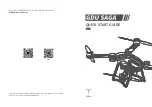
Quick start guide
4
Executing a flight
Goal of this section:
This section describes how to prepare your
eBee RTK
for flight, launch, monitor and control from the air, and ini-
tiate an autonomous landing.
Note:
We recommend that you perform your first flight in a large
obstacle-free area and limit the length of the mission in order to fa-
miliarise yourself with the
eBee RTK
in flight.
4.1
Weather check
Before each flight, you should be aware of the weather conditions. The
eBee RTK
is a small drone that cannot fly in heavy rain or strong wind conditions. In case of
doubt, make sure to check a weather bulletin including wind estimations in the
flight area. Note that wind is often stronger at higher altitudes and that the wind
perceived at the surface is not always a good reference to estimate the wind at
flight altitude. Cloud velocity or tall tree movements can help you to estimate the
wind speed once you are out in the field.
Weather forecasts may use various units to measure wind speed. As a reference,
1 m/s = 3.6 km/h = 2.24 mph = 1.94 kts.
40
Summary of Contents for EBEE RTK
Page 1: ...Extended User Manual eBee RTK Revision 3 December 2014 Copyright 2010 2015 senseFly Ltd ...
Page 14: ......
Page 71: ...Part II Advanced functionalities ...
Page 147: ...Part III Maintenance Repair and Troubleshooting ...
Page 182: ......
Page 183: ...Part IV Specifications ...








































